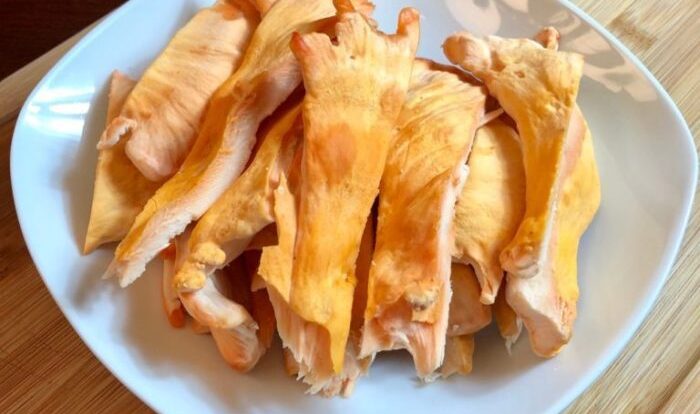
Chicken of the woods recipe – Chicken of the woods, the majestic mushroom with a taste that rivals chicken, is a culinary treasure waiting to be explored. Join us as we delve into the world of this delectable delicacy, uncovering its culinary secrets and guiding you towards creating unforgettable dishes.
From grilling to roasting, sautéing to stir-frying, we’ll unveil the versatility of chicken of the woods, showcasing the distinct flavors and textures it offers with each cooking method. Along the way, we’ll share expert tips on how to enhance its taste with seasonings and sauces, transforming your dishes into culinary masterpieces.
Recipe Variations

Chicken of the woods is a versatile mushroom that can be cooked in a variety of ways. Grilling, roasting, sautéing, and stir-frying are all popular methods that produce different flavors and textures.
Grilling chicken of the woods gives it a smoky flavor and a slightly crispy texture. Roasting chicken of the woods in the oven results in a more tender and juicy mushroom. Sautéing chicken of the woods in a pan with butter or oil is a quick and easy way to cook it, and it produces a flavorful and slightly chewy mushroom.
Stir-frying chicken of the woods with other vegetables is a great way to add it to a healthy and flavorful meal.
Seasonings and Sauces
Chicken of the woods has a mild flavor, so it can be seasoned with a variety of herbs and spices. Some popular seasonings for chicken of the woods include garlic, thyme, rosemary, oregano, and paprika. Chicken of the woods can also be cooked in a variety of sauces, such as a simple butter sauce, a creamy mushroom sauce, or a tangy barbecue sauce.
Nutritional Value and Health Benefits
Chicken of the woods is a nutritional powerhouse, boasting an impressive array of vitamins, minerals, and antioxidants. It’s a rich source of fiber, which promotes digestive health, and is low in calories and fat.
Vitamins and Minerals
- Vitamin D: Essential for bone health and immune function.
- Vitamin C: A powerful antioxidant that protects cells from damage.
- Potassium: Regulates blood pressure and heart function.
- Iron: Prevents anemia and supports oxygen transport.
Antioxidants, Chicken of the woods recipe
- Ergosterol: Converted to vitamin D when exposed to sunlight.
- Polyphenols: Anti-inflammatory compounds that protect against chronic diseases.
Health Benefits
- Anti-inflammatory: May reduce inflammation and alleviate symptoms of conditions like arthritis.
- Immune-boosting: Rich in antioxidants that support the immune system.
- Cholesterol-lowering: Fiber content helps lower cholesterol levels.
Incorporating into a Healthy Diet
Chicken of the woods is a versatile ingredient that can be incorporated into a variety of dishes. It can be sautéed, grilled, roasted, or used in soups and stews. Its mild flavor makes it a great addition to vegetarian and vegan dishes as a meat substitute.
If you’re looking for a unique and flavorful dish, look no further than the chicken of the woods recipe . This wild mushroom has a meaty texture that resembles chicken, making it a great vegetarian or vegan alternative. Plus, it’s packed with nutrients and antioxidants, so it’s a healthy choice too!
Foraging and Identification

Chicken of the woods ( Laetiporus sulphureus) is a widely distributed mushroom known for its distinctive appearance and delicious flavor.
Habitat and Seasonality
Chicken of the woods grows on dead or dying hardwood trees, particularly oaks, maples, and beeches. It is found in both temperate and tropical regions and fruits in late summer and fall. Look for it on the trunks or fallen logs of deciduous trees.
Characteristics
Chicken of the woods is characterized by its bright orange to yellow coloration and large, shelf-like shape. The caps can range in size from a few inches to over a foot in diameter and are often found in clusters. The flesh is white and tender, with a slightly fruity flavor and a meaty texture when cooked.
Safe Foraging
It is essential to be able to correctly identify chicken of the woods before foraging. There are several similar-looking mushrooms, some of which are poisonous. Always consult with an experienced forager or use reliable identification guides when foraging for wild mushrooms.
- Look for the bright orange to yellow coloration and shelf-like shape.
- Check the pores on the underside of the cap. Chicken of the woods has large, round pores, while poisonous lookalikes may have smaller, irregular pores.
- Avoid mushrooms that are growing on coniferous trees or have a bitter taste.
If you are unsure about the identity of a mushroom, it is always best to err on the side of caution and leave it alone.
Culinary Applications
Chicken of the woods is a versatile culinary ingredient that can be used in a variety of dishes. Its unique flavor and texture make it a popular choice for soups, stews, pasta dishes, pizzas, and other dishes.Chicken of the woods has a meaty texture that is similar to chicken, and its flavor is slightly sweet and nutty.
This makes it a great substitute for chicken in many recipes. It can be used in soups, stews, and casseroles, or it can be grilled, roasted, or fried.
Soups and Stews
Chicken of the woods is a great addition to soups and stews. It adds a meaty flavor and texture to the dish, and it can be used in place of chicken or beef.
Pasta Dishes
Chicken of the woods can also be used in pasta dishes. It can be added to a creamy Alfredo sauce, or it can be used in a tomato-based sauce.
Pizzas
Chicken of the woods is a great topping for pizzas. It can be used in place of chicken or sausage, and it adds a unique flavor and texture to the pizza.
Other Dishes
Chicken of the woods can also be used in a variety of other dishes, such as tacos, burritos, and stir-fries. It is a versatile ingredient that can be used in many different ways.
Preservation and Storage
Chicken of the woods can be preserved through various methods, including drying, freezing, and pickling, to extend its shelf life and enjoy its unique flavor beyond the fresh season.
Drying is an effective way to preserve chicken of the woods, as it removes moisture and inhibits microbial growth. To dry chicken of the woods, slice it thinly and place it in a dehydrator or oven at a low temperature (140-160°F) for several hours or until completely dry.
Dried chicken of the woods can be stored in an airtight container in a cool, dry place for up to 6 months.
Freezing
Freezing is another convenient method to preserve chicken of the woods. To freeze chicken of the woods, clean and cut it into desired sizes, then blanch it in boiling water for 2-3 minutes to stop enzymatic reactions. Drain and cool the chicken of the woods before freezing it in airtight containers or freezer bags for up to 6 months.
Pickling
Pickling is a traditional method of preserving chicken of the woods that involves submerging it in a vinegar-based solution. To pickle chicken of the woods, clean and cut it into bite-sized pieces, then boil it in a vinegar solution (equal parts vinegar and water) with spices and seasonings for 10-15 minutes.
Store the pickled chicken of the woods in airtight jars in a cool, dark place for up to 6 months.
Proper storage is crucial to maintain the freshness and flavor of chicken of the woods. Store fresh chicken of the woods in a paper bag or perforated plastic bag in the refrigerator for up to 5 days. Dried chicken of the woods can be stored in an airtight container in a cool, dry place for up to 6 months, while frozen chicken of the woods can be stored in the freezer for up to 6 months.
Another must-try is the chicken of the woods recipe from Fresno. This version uses a blend of herbs and spices to create a savory and aromatic dish. The chicken of the woods is sautéed until golden brown, then simmered in a flavorful broth.
Serve it over rice or pasta for a complete meal.
To determine if chicken of the woods has gone bad, check for signs of spoilage such as mold, sliminess, or an off odor. Discard any chicken of the woods that shows signs of spoilage.
Closing Summary: Chicken Of The Woods Recipe

Whether you’re a seasoned forager or a novice in the kitchen, our comprehensive guide to chicken of the woods will empower you to embrace its culinary potential. With our guidance, you’ll learn how to identify, forage, and preserve this remarkable mushroom, ensuring that its unique flavor graces your table for years to come.
Key Questions Answered
Can chicken of the woods be eaten raw?
No, chicken of the woods should not be eaten raw. Cooking it ensures its digestibility and removes any potential toxins.
What does chicken of the woods taste like?
Chicken of the woods has a mild, slightly nutty flavor that resembles chicken, making it a versatile ingredient for various dishes.
How can I store chicken of the woods?
Fresh chicken of the woods can be stored in the refrigerator for up to a week. For longer storage, it can be dried, frozen, or pickled.





